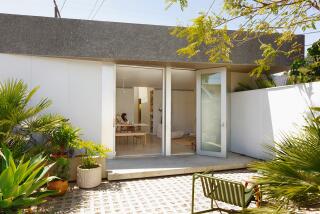Craig Ellwood; Architect Designed Art Center College
Craig Ellwood, who was trained as an engineer but established an international reputation as an imaginative yet pragmatic architect, only to exchange that career for art, has died.
Robert J. Brandt, a longtime family friend, said Sunday that Ellwood died in the Italian town of Pergine-Valdarno near Florence where he had lived since the late 1970s.
Brandt said Ellwood was 70 and died of an apparent aneurysm Friday.
Before turning to what critics called “hard-edged canvases” that evolved from his linear training as a UCLA engineering student, Ellwood designed some of the most fluid steel and glass structures in the world.
They ranged from churches to post offices to exclusive Beverly Hills homes, the widely acclaimed Security Pacific Bank Building at Wilshire Boulevard and Bedford Drive, and the Art Center College of Design in Pasadena where steel trusses seemingly float the buildings across the landscape.
In the early 1950s, he and such other energized design talents as Charles and Ray Eames, Richard Neutra, Raphael Soriano and Quincy Jones had set out to redefine the character of the American home.
“Los Angeles was a wonderful place to be in the 1950s,” Ellwood said in a 1989 interview with Times architecture writer Leon Whiteson.
“The city was wide open, eager for experiment. The feeling that, finally, we were going to get the chance to create a truly honest architecture was like wine in the air.”
The so-called Case Study homes he and others designed at that point featured a minimum of internal walls to allow for spacious, flexible interiors and integrated indoor and outdoor living through the use of sliding glass screen doors. Living rooms were built at the rear of the property, off the street.
In the 1987 anthology “Contemporary Architects,” Ellwood’s Hale House in Beverly Hills (1950) was praised as a “thoughtful, craftsmanly mind at work in the relationship of material to material.” His Courtyard Apartments in Hollywood (1953) won national and international awards.
In the mid-1950s and ‘60s, Ellwood turned to commercial buildings, designing the South Bay Bank in Manhattan Beach, the Westchester Post Office, factories for Litton Systems and Xerox Data Systems and his own office building on Robertson Boulevard. His home designs also continued apace, with projects in Malibu, Hollywood, Pasadena and San Luis Obispo.
Ellwood was credited with perfecting the idea of framing his designs in grids of steel and then filling in the expanses with glass.
By the 1970s, however, this machined, reserved style fell temporarily into disfavor and Ellwood took his thoughts to paint and canvas.
“My architecture,” he said in 1978, “was rigid and I’ve always been a romantic at heart.” Plus, he added wistfully, architecture “wasn’t exciting anymore.”
First from his rustic home on Mulholland Drive and later at the 15th-Century farmhouse that he restored in Italy, he drew hard lines on canvas, using tape and a drafting knife to achieve the edges that became a hallmark of his elegant intersecting planes.
He worked in large squares of acrylic and arranged them in diamond or diagonal shapes. Some were designed to be turned on edge when they were displayed.
Born in Texas, Ellwood came with his family to California, where he picked fruit for 12 cents an hour. He studied structural engineering at night, joined the Air Force in 1942 and after his discharge in 1946 went to work for a construction company.
He never formally studied architecture but learned the skills of the draftsman-engineer, combining them with his aesthetic sense.
With the help of a friend, he played the stock market with his early earnings from home design, and the postwar Wall Street boom made possible his own firm.
Throughout his career he was honored by such disparate organizations as Los Angeles Beautiful, the National Endowment for the Arts and the International Exhibition of Architecture in Sao Paulo, Brazil, while lecturing and teaching at Yale, Cornell and Syracuse universities.
His survivors include his wife, Leslie, their daughter, Catlin, and children from a previous marriage. He will be buried in Italy, Brandt said.
More to Read
The biggest entertainment stories
Get our big stories about Hollywood, film, television, music, arts, culture and more right in your inbox as soon as they publish.
You may occasionally receive promotional content from the Los Angeles Times.










